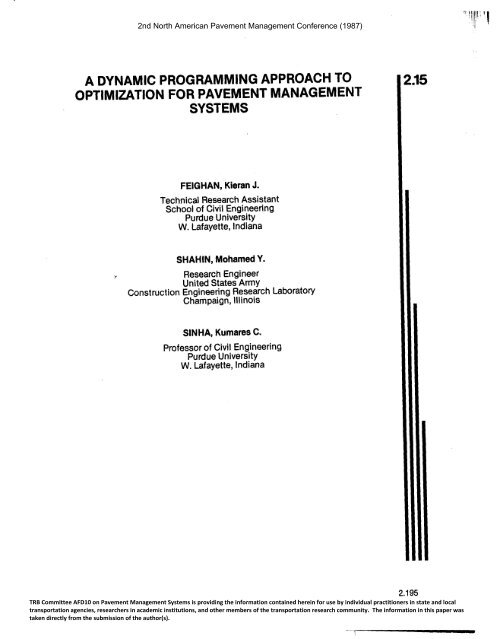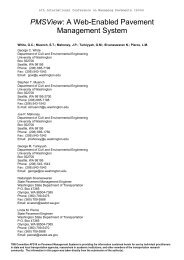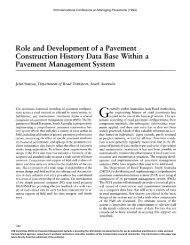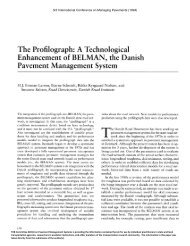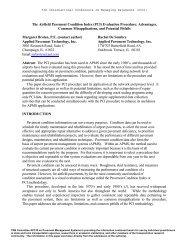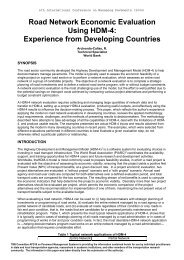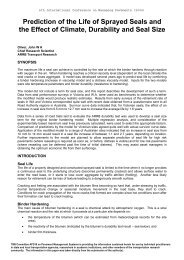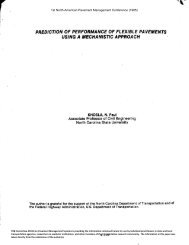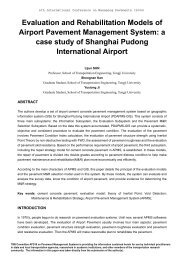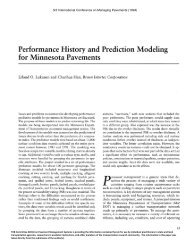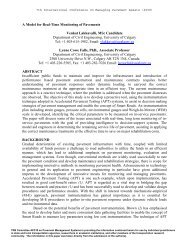a dynamic programming approach to optimization for pavement ...
a dynamic programming approach to optimization for pavement ...
a dynamic programming approach to optimization for pavement ...
You also want an ePaper? Increase the reach of your titles
YUMPU automatically turns print PDFs into web optimized ePapers that Google loves.
2nd North American Pavement Management Conference (1987)MARKOV PREDICTION MODEL1t is not possible <strong>to</strong> describe the functioning of the <strong>dynamic</strong><strong>programming</strong> algorithm without first describing the predictionmodel used, as the two are inextricably linked. The following isa necessarily abbreviated and generalized desciption of themodel; a more detailed and comprehensive description has alreadybeen published elsewhere (3,5). Much of the terminology used inthis description also is used in <strong>dynamic</strong> <strong>programming</strong>.The PC1 range of 0 <strong>to</strong> 100 is divided in<strong>to</strong> 10 states,each state being 10 PC1 points wide. A <strong>pavement</strong> is modelled <strong>to</strong>begin its life in near-perfect condition, and <strong>to</strong> deteriorate asit is subjected <strong>to</strong> a sequence of duty-cycles. A duty-cycle isdefined as one year's imposition of the effects of weather andtraffic. A state vec<strong>to</strong>r indicates the probability of a <strong>pavement</strong>section being in each of the 10 states in any given year. Figure1 shows the schematic representation of state, state vec<strong>to</strong>r andduty cycle.The sections are grouped in<strong>to</strong> families, and all of thesections of a family are categorized in<strong>to</strong> one of the ten statesat any age. It is assumed that all of the <strong>pavement</strong> sections arein state 1 (PC1 of 90 <strong>to</strong> 100) at an age of 0 years.To model the way in which the <strong>pavement</strong> deterioriateswith time, it is necessary <strong>to</strong> identify the Markov probabilitymatrix. The assumption made is that the <strong>pavement</strong> condition willnot drop by more than one state in a single year. Thus, the<strong>pavement</strong> will either stay in its current state or transit <strong>to</strong> thenext lowest state in one year. The probability transition matrixhas a diagonal structure as shown in Figure 2. The entry of 1 inthe last row of the transition matrix indicates a trappingstate. The <strong>pavement</strong> condition cannot transit from this stateunless repair action is per<strong>for</strong>med.The state vec<strong>to</strong>r <strong>for</strong> any duty cycle t,S(t), is obtainedby multiplying the initial state vec<strong>to</strong>r S(0) by the transitionmatrix P raised <strong>to</strong> the power of t. ThusIf the transition matrix probabilities can be estimated, thefuture condition of the road at any duty cycle (time) t can bepredicted.The probabilities are estimated using a non-linear <strong>programming</strong><strong>approach</strong> which has its objective function theminimization of the absolute distance between the actual PC1versus age data points, and the expected (predicted) PC1 <strong>for</strong> thecorresponding age generated by the Markov chain using the nineprobability parameters. It has been found that this <strong>approach</strong> canaccurately model the <strong>pavement</strong> deterioration over time. A sampleoutput of this program is shown in Figure 3.TRB Committee AFD10 on Pavement Management Systems is providing the in<strong>for</strong>mation contained herein <strong>for</strong> use by individual practitioners in state and localtransportation agencies, researchers in academic institutions, and other members of the transportation research community. The in<strong>for</strong>mation in this paper wastaken directly from the submission of the author(s).
2nd North American Pavement Management Conference (1987)I STATE IISTATE VECTORTRB Committee AFD10 on Pavement Management Systems is providing the in<strong>for</strong>mation contained herein <strong>for</strong> use by individual practitioners in state and localtransportation agencies, researchers in academic institutions, and other members of the transportation research community. The in<strong>for</strong>mation in this paper wastaken directly from the submission of the author(s).
2nd North American Pavement Management Conference (1987)INTRODUCTION TO DYNAMIC PROGRAMMINGDynamic <strong>programming</strong> is an "<strong>approach</strong>" <strong>to</strong> <strong>optimization</strong>. It is notbased upon a single, well-defined procedure such as the simplexalgorithm of linear <strong>programming</strong>. Rather, it seeks <strong>to</strong> take asingle, complicated problem and break it down in<strong>to</strong> a number ofsimpler, more easily solvable problems. The solution <strong>to</strong> theseproblems is generally much faster and requires much lesscomputational ef<strong>for</strong>t.The principle of optimality, the foundation of <strong>dynamic</strong><strong>programming</strong>, states that "every optimal policy consists only ofoptimal subpolicies" (6). Instead of examining all possiblecombinations of decisions, <strong>dynamic</strong> <strong>programming</strong> examines a small,carefully chosen subset of the ombinations, rejecting thosecombinations that cannot possibly t a d <strong>to</strong> an optimal solution.If per<strong>for</strong>med correctly, the subset examined is guaranteed <strong>to</strong>contain the optimal solution.\Dynamic <strong>programming</strong> has the advantage over almost allclassical <strong>optimization</strong> techniques that it will yield the absoluteor global maxima or minima rather than local optima. Dynamic<strong>programming</strong> is also extremely robust in that it can handleintegrality, negativity and discreetness of variables and otherconstraints very easily. It also, by its nature, produces theoptimal solution <strong>to</strong> all of its constituent subproblems. Thesesolutions may be of interest <strong>to</strong> the <strong>pavement</strong> manager, especiallyin time-varying problems such as <strong>pavement</strong> per<strong>for</strong>mance.The major drawback with <strong>dynamic</strong> <strong>programming</strong> is that theproposed problem <strong>to</strong> be solved may not be <strong>for</strong>mulatable in a mannercapable of using the power of <strong>dynamic</strong> <strong>programming</strong> effectively.However, if it is possible <strong>to</strong> set up the problem in an effective<strong>for</strong>m, <strong>dynamic</strong> <strong>programming</strong> provides an outstanding <strong>optimization</strong><strong>to</strong>ol.Structure of <strong>dynamic</strong> <strong>programming</strong>: The basic components of<strong>dynamic</strong> <strong>programming</strong> are states, stages, decision variables,returns and trans<strong>for</strong>mation or transition functions (6). Aphysical system is considered <strong>to</strong> progress through a series ofconsecutive stages. In <strong>pavement</strong> per<strong>for</strong>mance, each year is viewedas a stage.At each stage, the system must be capable of being fullydescribed by the state variables or state vec<strong>to</strong>r. In the presentcase, as described earlier, each state is a 10 PC1 bracket <strong>for</strong>every <strong>pavement</strong> family and the condition of the <strong>pavement</strong> at anyyear (stage) can be defined as being in one of the ten states.At each stage, <strong>for</strong> every possible state, there must be aset of allowable decisions. The decisions being made in the<strong>dynamic</strong> <strong>programming</strong> model are what repair alternative <strong>to</strong>implement in each state at every stage.Finally, there is the trans<strong>for</strong>mation or transitionfunction- If a process is in a given state, and a feasibledecision is made, there must be a function that determines <strong>to</strong>which state the process moves. In general, <strong>dynamic</strong> <strong>programming</strong>trans<strong>for</strong>mation functions can be deterministic or s<strong>to</strong>chastic. InTRB Committee AFD10 on Pavement Management Systems is providing the in<strong>for</strong>mation contained herein <strong>for</strong> use by individual practitioners in state and localtransportation agencies, researchers in academic institutions, and other members of the transportation research community. The in<strong>for</strong>mation in this paper wastaken directly from the submission of the author(s).
this particular case, the transition fupction is defined by theMarkov probability matrix derived in the curve-fitting processdescribed earlier and hence is a s<strong>to</strong>chastic process.In summary, the problem set-up <strong>for</strong> this <strong>dynamic</strong><strong>programming</strong> <strong>for</strong>mulation is:MINIMIZE: Expected Cost over a specified life-cycle lengthsubject <strong>to</strong> keeping all sections above a defined per<strong>for</strong>mancestandard.The <strong>dynamic</strong> <strong>programming</strong> parameters are:STATES: Each bracket of 10 PC1 points in a family.STAGES: Each year in the analysis period.DECISION VARIABLES: Which maintenance treatment <strong>to</strong> apply.TRANSFORMATION FUNCTION: The Markov Transition ProbabilityMatrix defines the trans<strong>for</strong>mation.RETURN: Expected cost if a particular decision is made in eachstate at each stage.INPUTS REQUIRED FOR THE DYNAMIC PROGRAMMING ALGORITHMThe inputs required <strong>for</strong> the <strong>dynamic</strong> <strong>programming</strong> algorithm are:2nd North American Pavement Management Conference (1987)'fpij ; i = 1,..,10 statesj = 1, ..,m families2. Cost of applying treatment k <strong>to</strong> family j in state iCi.k ; k = l,..,n maintenance alternatives4. Number of Years in the life-cycle analysis; N5. Interest Rate ; r6. Idflation Rate ; f7. Rate of Increase in Funding ; qdeteriorate <strong>to</strong> be<strong>for</strong>e per<strong>for</strong>ming some major maintenance.designated by S j*1. Markov Transition Probabilities <strong>for</strong> state i of matrix jRoutine maintenance is always designated as k -1.The cost is entered on a dollar per square yard basis.3. Feasibility Indica<strong>to</strong>r <strong>for</strong> alternative k when in state i offamily j.Rijk = 1 if maintenance alternative is feasible= 0 if maintenance alternative is infeasible8. The associated benefit over one year of being in state iBi = 95, 85,.., 5 <strong>for</strong> i = 1,2,.., 10The benefit is taken <strong>to</strong> be the area under the PC1 curve overa period of one year.9. The minimum allowable state <strong>for</strong> each family, i.e. the loweststate that the network manager will allow a particular family <strong>to</strong>This isTRB Committee AFD10 on Pavement Management Systems is providing the in<strong>for</strong>mation contained herein <strong>for</strong> use by individual practitioners in state and localtransportation agencies, researchers in academic institutions, and other members of the transportation research community. The in<strong>for</strong>mation in this paper wastaken directly from the submission of the author(s).
2nd North American Pavement Management Conference (1987)FAMILY JRoutine Maintenence(K = 1)FAMILY J'Non Routine OptionY STAGE N N-1 ii 118n-2I I!:STAGE N N-1 • • • n n-1 n-2FIGURE 4TRB Committee AFD10 on Pavement Management Systems is providing the in<strong>for</strong>mation contained herein <strong>for</strong> use by individual practitioners in state and localtransportation agencies, researchers in academic institutions, and other members of the transportation research community. The in<strong>for</strong>mation in this paper wastaken directly from the submission of the author(s).
2nd North American Pavement Management Conference (1987)after the repair alternative is carried out. The family that the<strong>pavement</strong> moves <strong>to</strong> as a result of having this alternative9 j 9per<strong>for</strong>med is defined in the input trans<strong>for</strong>mation matrix. pOrexample, if a thin overlay is per<strong>for</strong>med on an AC <strong>pavement</strong>section, that section will move <strong>to</strong> the thin overlay family <strong>for</strong>per<strong>for</strong>mance prediction after the overlay is placed.a*The optimal cost is then given by:with the associated optimal maintenance alternative <strong>to</strong> beper<strong>for</strong>med <strong>for</strong> this (i,j) familylstate cqmbination in year N - ~being the choice' of k that minimizes the above expression.This backward recursion is per<strong>for</strong>med <strong>for</strong> everysuccessive year of the analysis period until the analysis <strong>for</strong>year 0, or stage N, is reached.Dynamic Programming OutputThe output from the <strong>dynamic</strong> <strong>programming</strong> program consists of:(i) a file containing the optimal maintenance alternative inevery year <strong>for</strong> every familylstate combination.(ii) the discounted present worth costs expected <strong>to</strong> be accruedover the life-cycle specified if the optimal decisions areimplemented.(iii) the expected effectiveness accrued as a result of followingthe optimal decisions is calculated <strong>for</strong> every familylstatecombination.(iv) the effectiveness/cost ratio <strong>for</strong> every familylstatecombination is calculated.Thus, all that is necessary is <strong>to</strong> define which familylstatecombination any particular section belongs <strong>to</strong>, and the optimalmaintenance alternative and associated cost and effectiveness arereadily obtained. As the intention of the research is <strong>to</strong> produceupdated programs <strong>for</strong> both the PAVER and Micro PAVER systems, itwas imperative that all of the programs be executable on a microcomputer.The <strong>dynamic</strong> <strong>programming</strong> program executes extremelyquickly at this level.A very short example follows <strong>to</strong> illustrate the operationof the program. Per<strong>for</strong>mance curves were developed <strong>for</strong> the GreatLakes Naval Center based on PC1 surveys per<strong>for</strong>med there.Families were defined on the basis of branch use and surfacetype. For the branch use of "roadway", there were four familiesdefined: asphalt concrete, surface treated, thin overlay andstructural overlay.There were four maintenance alternatives considered;routine maintenance, surface treatment, thin overlay and structuraloverlay. Dollar cost as a function of PC1 was defined <strong>for</strong>both initial repair cost and subsequent routine maintenance costin the Purdue University research [4]. Markov probabilitycalculations <strong>for</strong> each family were per<strong>for</strong>med, and the probabilitytransition matrices obtained.TRB Committee AFD10 on Pavement Management Systems is providing the in<strong>for</strong>mation contained herein <strong>for</strong> use by individual practitioners in state and localtransportation agencies, researchers in academic institutions, and other members of the transportation research community. The in<strong>for</strong>mation in this paper wastaken directly from the submission of the author(s).
2nd North American Pavement Management Conference (1987)The <strong>dynamic</strong> <strong>programming</strong> program was then run on a Compaq286 microcomputer with an 80287 math co-processor installed. Aneffective interest rate of 5% was input, and a life-cycleanalysis of 30 years was specified. The program <strong>to</strong>ok 45 seconds<strong>to</strong> produce the entire output <strong>for</strong> every year of the 30 years.Figure 5 illustrates a small part of the output. Thisis the output in year 1, the present time, <strong>for</strong> family 4. This isthe family composed of sections with structural overlays. As canbe seen, routine maintenance was selected as the optimal treatment<strong>to</strong> apply in the upper states, surface treatment in themiddle states and structural overlay in the lower states.obviously, this result is completely dependent upon the cost andper<strong>for</strong>mance relationships defined, but the overall trend of theoptimal decisions is certainly reasonable.FUTURE DEVELOPMENTSThere are a number of potential areas <strong>for</strong> further use of this<strong>approach</strong> in <strong>pavement</strong> management. It should be possible <strong>to</strong>explore the impact of deferred maintenance by limiting themaintenance options available <strong>to</strong> just routine maintenance <strong>for</strong> agiven number of years, and noting the detrimental effect thatthis policy has on the cost and E/C ratios <strong>for</strong> the life-cycleperiod.The o~tput from <strong>dynamic</strong> <strong>programming</strong> fits easily in<strong>to</strong> anetwork prioritization framework. The flowchart describing theoverall intended process is shown in Figure 6. The details ofthe prioritization package will be described in the future. Itis also intended <strong>to</strong> validate the <strong>dynamic</strong> <strong>programming</strong> outputs <strong>for</strong>a number of different databases by comparing its output <strong>to</strong> tha<strong>to</strong>btained from a more traditional, deterministic <strong>approach</strong> <strong>to</strong> lifecycleeffectiveness and cost calculation.REFERENCES1. Shahin a'nd Kohn, "Overview of the 'PAVER' Pavement ManagementSystem", Technical Manuscript M-310, USA-CERL, January 1982.2. Shahin, Nunez, Broten, Carpenter and Sameh, "New Techniques<strong>for</strong> Modeling Pavement Deterioration", Presented at TransportationResearch Board Annual Meeting, January 1987.3. Butt, Shahin, Feighan, Carpenter, "Pavement Per<strong>for</strong>mancePrediction Model Using the Markov Process", Presented atTransportation Research Board Annual Meeting, January 1987.4. Reichelt, Sharaf, Sinha and Shahin, "The Relationship ofPavement Maintenance Costs <strong>to</strong> the Pavement Condition Index",USA-CERL Interim Report M-87/02, February 1987.5. Keane and Wu, "An Integrated Decision-Making Methodology <strong>for</strong>Optimal Maintenance Strategies", Master's Thesis, University ofIllinois, 1985.6. Cooper and Cooper, "Introduction <strong>to</strong> Dynamic Programming",Pergamon Press, 1981.2.205TRB Committee AFD10 on Pavement Management Systems is providing the in<strong>for</strong>mation contained herein <strong>for</strong> use by individual practitioners in state and localtransportation agencies, researchers in academic institutions, and other members of the transportation research community. The in<strong>for</strong>mation in this paper wastaken directly from the submission of the author(s).
2nd North American Pavement Management Conference (1987)rWINTENANCECILTERNATIVEPRESENT WORTHCOSTEFFECTIVENESSE/C RATIOR.n.R.H.R.H.8.1.S.T.S.T.5.0.S.O.S.O.S.O.17.3521.2022.5223.2623.8624.7125-8128.8433.8438.842402.02276.62305.02353.92341 -92331.92342.02332.02322 0 .2312.0138.5107.4102.3101.198.294.490.780.968.659.5FIGURE 5IPAVER DATABASE RhW DATA IiINPUT: Common Characteristics <strong>to</strong> clas~ify sectionsin<strong>to</strong> families (rurfacm type, traffic, primary sourceof distress).OUTPUT: Families of pavemmnt sections with PC1versus Age data.IHARKOV PREDICTION PROCESSINPUT: Families with PC1 vetrue Age data.OUTPUT: narkov Transition Probabilities <strong>for</strong> eachfamily and maintenance alternative.IIDYNAHIC PROGRAHHING PROGRAM IINPUT: narkov Transition Probabilities, costs bystatm and family <strong>for</strong> each alternative, planninghorizon, interest rates, per<strong>for</strong>mance standards byfamily, benefit by state.OUTPUTI Optimal maintmmcr drcision (on thr basirof minimized Cost or maximized B/C ratio) <strong>for</strong> eachstate of each family1 associated cost and benefit.IIPRIORITIZATION PROGRAHI IINPUT: B/C ratio <strong>for</strong> mach sectionr weights byfamily (and possibly by state), Actual Budget,my nmcmssary (user-definmd) rections that mustbe repairmd, evrn if wb-optimal.OUTPUT: Ranked list of sections that can bmrepaired within budget limitations.IPROJECT LEVEL ANALYSISFIGURE 6IITRB Committee AFD10 on Pavement Management Systems is providing the in<strong>for</strong>mation contained herein <strong>for</strong> use by individual practitioners in state and localtransportation agencies, researchers in academic institutions, and other members of the transportation research community. The in<strong>for</strong>mation in this paper wastaken directly from the submission of the author(s).


